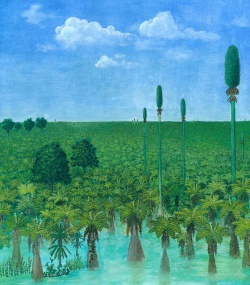A “Permian Pompeii” Described in New Study
Chinese Fossil Site Preserves Ancient Permian Ecosystem
A treasure trove of Permian aged plant fossils have been discovered in northern China by a team of U.S./Chinese scientists. A volcanic eruption some 298 million years ago (Asselian faunal stage of the Early Permian), buried an entire ancient forest under many layers of fine ash, and this has led to the almost perfect preservation of a vast number of plant fossils – some preserved in situ with leaves, branches and even seed cones intact. Described as a “Pompeii-like site in recognition of the remarkable Roman town’s preservation after a volcanic eruption (Mount Vesuvius ) in AD79. This location, part of a Chinese coal-mine will provide palaeobotanists with a fascinating insight into the flora of our planet nearly 300 million years ago. A “Permian Pompeii” is given palaeontologists a rare opportunity to study an ancient ecosystem.
Studying the Climate of the Permian
A study by University of Pennsylvania, palaeobotanist Professor Hermann Pfefferkorn and colleagues provides information on the ecology and climate during this early part of the geological period known as the Permian. The paper has just been published in the scientific journal “The Proceedings of the National Academy of Sciences”.
The work has been conducted in collaboration with a number of Chinese scientists, with the study site, located in a remote part of northern China covering an area of more than 1,000 square metres. It seems that a massive volcanic eruption blanketed the surrounding area in a fine layer of ash in just a few days. This enabled the plants and tree-like structures in the forest to be preserved in a remarkably well-defined state. The plants have been preserved as they fell, in many cases in the exact locations where they had been growing. Relatively little transport of material has taken place.
Commenting on the significance of this location Professor Pfefferkorn stated:
“We can stand there and find a branch with the leaves attached, and then we find the next branch and the next branch and the next branch. And then we find the stump from the same tree. That’s really exciting.”
The researchers also found some smaller trees with leaves, branches, trunk and cones intact, preserved in their entirety.
“Permian Pompeii”
The scientists were able to date the ash layer to approximately 298 million years ago. That falls at the beginning of the Permian, during which Earth’s continental plates were still moving toward each other to form the super-continent Pangea.
The Permian was a period of great change, both in climate and the diversity and abundance in fauna and flora. The drying climate of the Permian led to the destruction of the huge coal swamps that had existed during the Carboniferous. This part of China was still close to the equator and tropical conditions here ensured the survival of this eco-system into the Permian.
An Artist’s Impression of the Chinese Coal Forest
Picture credit:University of Pennsylvania/Ren Yugao
In total, the U.S./Sino study team identified three locations where ash had preserved the remnants of an ancient forest, one that would have teemed with insects, amphibians and primitive reptiles. In all three sites, Pfefferkorn and his colleagues counted and mapped the fossilised plants they encountered. In all, they identified six groups of trees. Tree ferns formed a lower canopy while much taller trees — Sigillaria and Cordaites provided a canopy reaching heights in excess of twenty metres.
The researchers also found nearly complete specimens of a group of trees called Noeggerathiales. These extinct spore-bearing trees, relatives of ferns, had been identified from sites in North America and Europe but appeared to be much more common in these Asian sites.
They also observed that the three sites were somewhat different from one another in plant composition and diversity. For instance, in one site, for example, Noeggerathiales were fairly uncommon, while they made up the dominant plant type in another site.
Professor Pfefferkorn added:
“This is now the baseline. Any other finds, which are normally much less complete, have to be evaluated based on what we determined here.”
This is a remarkable discovery, most plant fossils consist of fragments, perhaps individual leaves, or a seed cone. This has led to the confusing situation of having several parts of the same plant – roots, truck, leaves etc. being classified as a separate taxonomic species – the Lepidodendron is a good example of this.
In a University of Pennsylvania press release it was noted that this location (near Wuda, northern China) was remarkable because it is the first such forest reconstruction in Asia for any time interval, it’s the first of a peat forest for this time interval and it’s the first with Noeggerathiales as a dominant group.
Because the site captures just one moment in Earth’s history, Pfefferkorn noted that it alone cannot explain how climate changes affected life on Earth, but it helps provide valuable context.
The Professor commented:
“It’s like Pompeii: Pompeii gives us deep insight into Roman culture, but it doesn’t say anything about Roman history in and of itself. But on the other hand, it elucidates the time before and the time after. This finding is similar. It’s a time capsule and therefore it allows us now to interpret what happened before or after much better.”
The study was supported by the Chinese Academy of Science, the National Basic Research Program of China, the National Natural Science Foundation of China and the University of Pennsylvania and we are grateful to the University of Pennsylvania for this press release information.
To view models and replicas of Permian prehistoric animals: CollectA Deluxe Prehistoric Animal Models.


